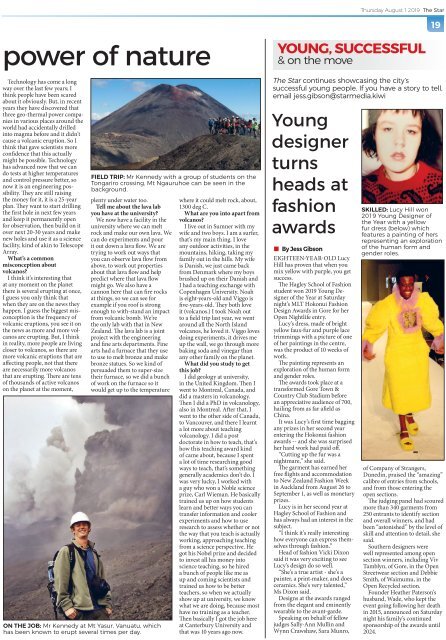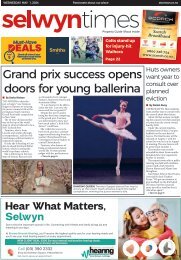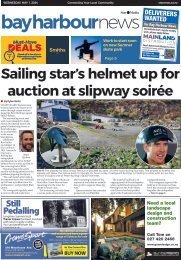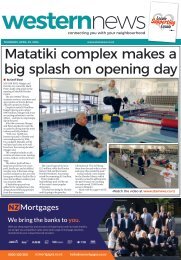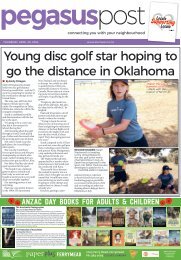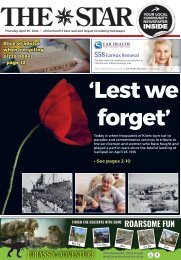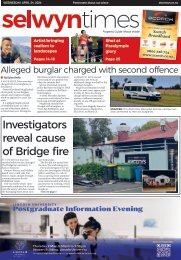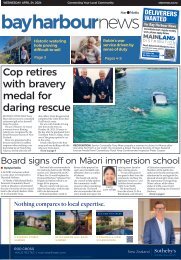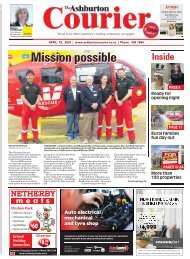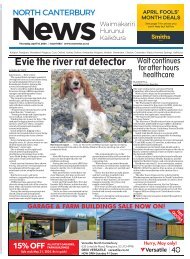The Star: August 01, 2019
You also want an ePaper? Increase the reach of your titles
YUMPU automatically turns print PDFs into web optimized ePapers that Google loves.
Thursday <strong>August</strong> 1 2<strong>01</strong>9 <strong>The</strong> <strong>Star</strong><br />
19<br />
power of nature<br />
YOUNG, SUCCESSFUL<br />
& on the move<br />
Technology has come a long<br />
way over the last few years; I<br />
think people have been scared<br />
about it obviously. But, in recent<br />
years they have discovered that<br />
three geo-thermal power companies<br />
in various places around the<br />
world had accidentally drilled<br />
into magma before and it didn’t<br />
cause a volcanic eruption. So I<br />
think that gave scientists more<br />
confidence that this actually<br />
might be possible. Technology<br />
has advanced now that we can<br />
do tests at higher temperatures<br />
and control pressure better, so<br />
now it is an engineering possibility.<br />
<strong>The</strong>y are still raising<br />
the money for it, it is a 25-year<br />
plan. <strong>The</strong>y want to start drilling<br />
the first hole in next few years<br />
and keep it permanently open<br />
for observation, then build on it<br />
over next 20-30 years and make<br />
new holes and use it as a science<br />
facility, kind of akin to Telescope<br />
Array.<br />
What’s a common<br />
misconception about<br />
volcanos?<br />
I think it’s interesting that<br />
at any moment on the planet<br />
there is several erupting at once,<br />
I guess you only think that<br />
when they are on the news they<br />
happen. I guess the biggest misconception<br />
is the frequency of<br />
volcanic eruptions, you see it on<br />
the news as more and more volcanos<br />
are erupting. But, I think<br />
in reality, more people are living<br />
closer to volcanos, so there are<br />
more volcanic eruptions that are<br />
affecting people, not that there<br />
are necessarily more volcanos<br />
that are erupting. <strong>The</strong>re are tens<br />
of thousands of active volcanos<br />
on the planet at the moment,<br />
plenty under water too.<br />
Tell me about the lava lab<br />
you have at the university?<br />
We now have a facility in the<br />
university where we can melt<br />
rock and make our own lava. We<br />
can do experiments and pour<br />
it out down a lava flow. We are<br />
trying to work out ways that<br />
you can observe lava flow from<br />
above, to work out properties<br />
about that lava flow and help<br />
predict where that lava flow<br />
might go. We also have a<br />
cannon here that can fire rocks<br />
at things, so we can see for<br />
example if you roof is strong<br />
enough to with-stand an impact<br />
from volcanic bomb. We’re<br />
the only lab with that in New<br />
Zealand. <strong>The</strong> lava lab is a joint<br />
project with the engineering<br />
and fine arts departments. Fine<br />
arts had a furnace that they use<br />
to use to melt bronze and make<br />
bronze statues. So we kind of<br />
persuaded them to super-size<br />
their furnace, so we did a bunch<br />
of work on the furnace so it<br />
would get up to the temperature<br />
ON THE JOB: Mr Kennedy at Mt Yasur, Vanuatu, which<br />
has been known to erupt several times per day.<br />
FIELD TRIP: Mr Kennedy with a group of students on the<br />
Tongariro crossing, Mt Ngauruhoe can be seen in the<br />
background.<br />
where it could melt rock, about,<br />
1300 deg C.<br />
What are you into apart from<br />
volcanos?<br />
I live out in Sumner with my<br />
wife and two boys. I am a surfer,<br />
that’s my main thing. I love<br />
any outdoor activities, in the<br />
mountains, hiking, taking my<br />
family out in the hills. My wife<br />
is Danish, we just came back<br />
from Denmark where my boys<br />
brushed up on their Danish and<br />
I had a teaching exchange with<br />
Copenhagen University. Noah<br />
is eight-years-old and Viggo is<br />
five-years-old. <strong>The</strong>y both love<br />
it (volcanos.) I took Noah out<br />
to a field trip last year, we went<br />
around all the North Island<br />
volcanos, he loved it. Viggo loves<br />
doing experiments, it drives me<br />
up the wall, we go through more<br />
baking soda and vinegar than<br />
any other family on the planet.<br />
What did you study to get<br />
this job?<br />
I did geology at university,<br />
in the United Kingdom. <strong>The</strong>n I<br />
went to Montreal, Canada, and<br />
did a masters in volcanology.<br />
<strong>The</strong>n I did a PhD in volcanology,<br />
also in Montreal. After that, I<br />
went to the other side of Canada,<br />
to Vancouver, and there I learnt<br />
a lot more about teaching<br />
volcanology. I did a post<br />
doctorate in how to teach, that’s<br />
how this teaching award kind<br />
of came about, because I spent<br />
a lot of time researching good<br />
ways to teach, that’s something<br />
generally academics don’t do. I<br />
was very lucky, I worked with<br />
a guy who won a Noble science<br />
prize, Carl Wieman. He basically<br />
trained us up on how students<br />
learn and better ways you can<br />
transfer information and cooler<br />
experiments and how to use<br />
research to assess whether or not<br />
the way that you teach is actually<br />
working, approaching teaching<br />
from a science perspective. He<br />
got his Nobel prize and decided<br />
to invest all his money into<br />
science teaching, so he hired<br />
a bunch of people like me as<br />
up and coming scientists and<br />
trained us how to be better<br />
teachers, so when we actually<br />
show up at university, we know<br />
what we are doing, because most<br />
have no training as a teacher.<br />
<strong>The</strong>n basically I got the job here<br />
at Canterbury University and<br />
that was 10 years ago now.<br />
<strong>The</strong> <strong>Star</strong> continues showcasing the city’s<br />
successful young people. If you have a story to tell,<br />
email jess.gibson@starmedia.kiwi<br />
Young<br />
designer<br />
turns<br />
heads at<br />
fashion<br />
awards<br />
• By Jess Gibson<br />
EIGHTEEN-YEAR-OLD Lucy<br />
Hill has proven that when you<br />
mix yellow with purple, you get<br />
success.<br />
<strong>The</strong> Hagley School of Fashion<br />
student won 2<strong>01</strong>9 Young Designer<br />
of the Year at Saturday<br />
night’s MLT Hokonui Fashion<br />
Design Awards in Gore for her<br />
Open Nightlife entry.<br />
Lucy’s dress, made of bright<br />
yellow faux-fur and purple lace<br />
trimmings with a picture of one<br />
of her paintings in the centre,<br />
was the product of 10 weeks of<br />
work.<br />
<strong>The</strong> painting represents an<br />
exploration of the human form<br />
and gender roles.<br />
<strong>The</strong> awards took place at a<br />
transformed Gore Town &<br />
Country Club Stadium before<br />
an appreciative audience of 700,<br />
hailing from as far afield as<br />
China.<br />
It was Lucy’s first time bagging<br />
any prizes in her second year<br />
entering the Hokonui fashion<br />
awards -- and she was surprised<br />
her hard work had paid off.<br />
“Cutting up the fur was a<br />
nightmare,” she said.<br />
<strong>The</strong> garment has earned her<br />
free flights and accommodation<br />
to New Zealand Fashion Week<br />
in Auckland from <strong>August</strong> 26 to<br />
September 1, as well as monetary<br />
prizes.<br />
Lucy is in her second year at<br />
Hagley School of Fashion and<br />
has always had an interest in the<br />
subject.<br />
“I think it’s really interesting<br />
how everyone can express themselves<br />
through fashion.”<br />
Head of fashion Vicki Dixon<br />
said it was very exciting to see<br />
Lucy’s design do so well.<br />
“She’s a true artist - she’s a<br />
painter, a print-maker, and does<br />
ceramics. She’s very talented,”<br />
Ms Dixon said.<br />
Designs at the awards ranged<br />
from the elegant and eminently<br />
wearable to the avant-garde.<br />
Speaking on behalf of fellow<br />
judges Sally-Ann Mullin and<br />
Wynn Crawshaw, Sara Munro,<br />
SKILLED: Lucy Hill won<br />
2<strong>01</strong>9 Young Designer of<br />
the Year with a yellow<br />
fur dress (below) which<br />
features a painting of hers<br />
representing an exploration<br />
of the human form and<br />
gender roles.<br />
of Company of Strangers,<br />
Dunedin, praised the “amazing”<br />
calibre of entries from schools,<br />
and from those entering the<br />
open sections.<br />
<strong>The</strong> judging panel had scoured<br />
more than 340 garments from<br />
250 entrants to identify section<br />
and overall winners, and had<br />
been “astonished” by the level of<br />
skill and attention to detail, she<br />
said.<br />
Southern designers were<br />
well represented among open<br />
section winners, including Viv<br />
Tamblyn, of Gore, in the Open<br />
Streetwear section and Debbie<br />
Smith, of Waimumu, in the<br />
Open Recycled section.<br />
Founder Heather Paterson’s<br />
husband, Wade, who kept the<br />
event going following her death<br />
in 2<strong>01</strong>5, announced on Saturday<br />
night his family’s continued<br />
sponsorship of the awards until<br />
2024.


